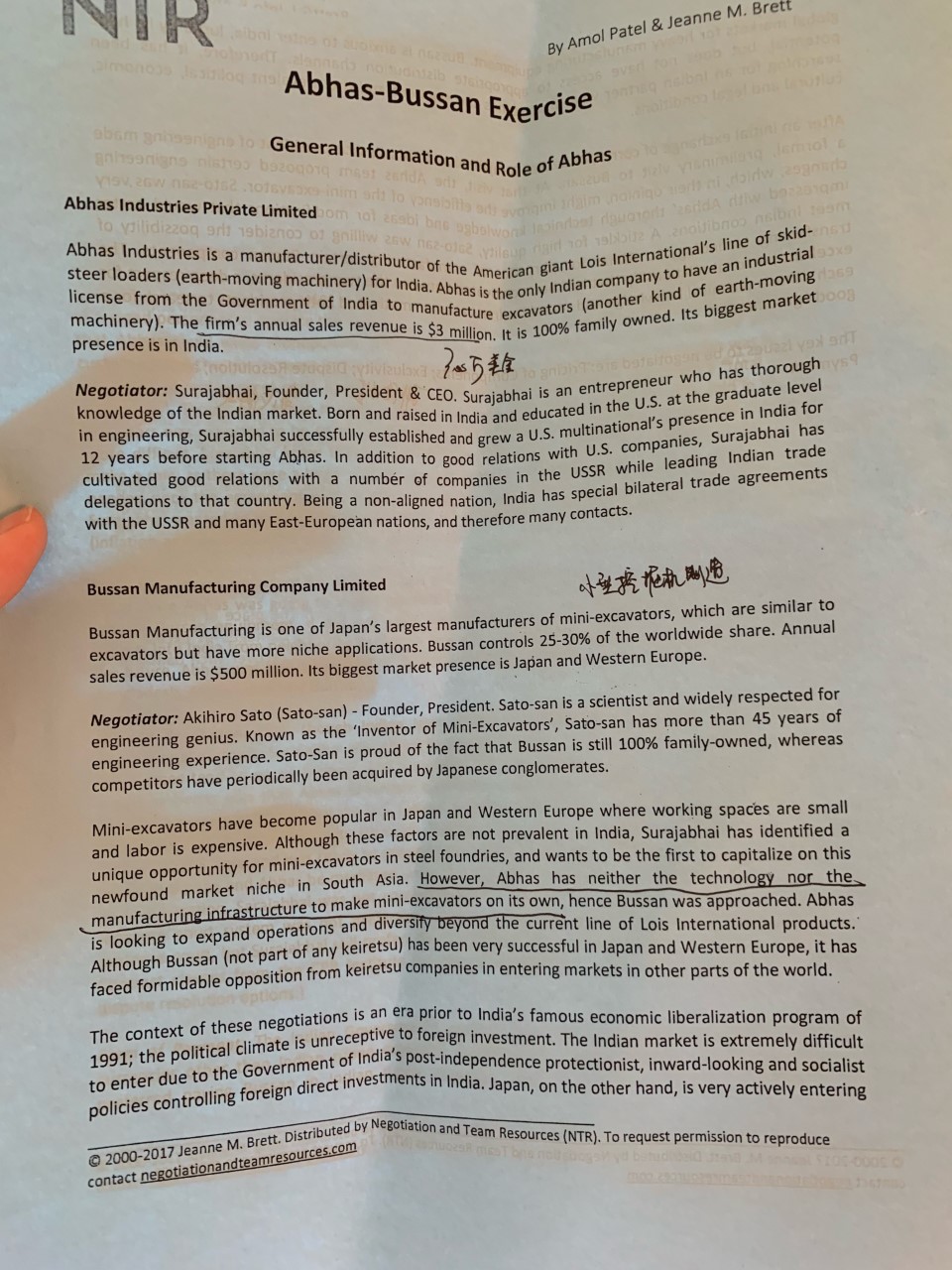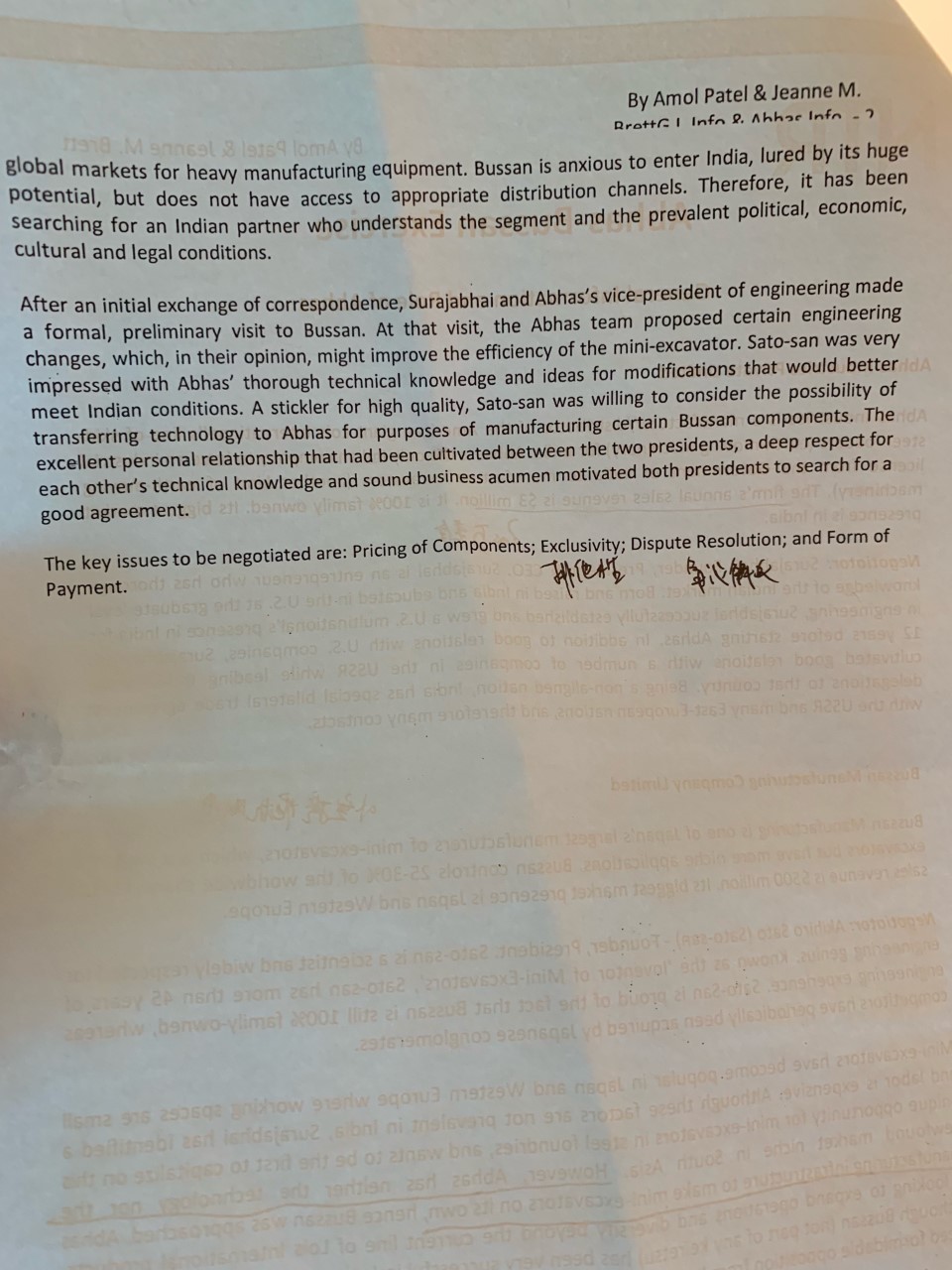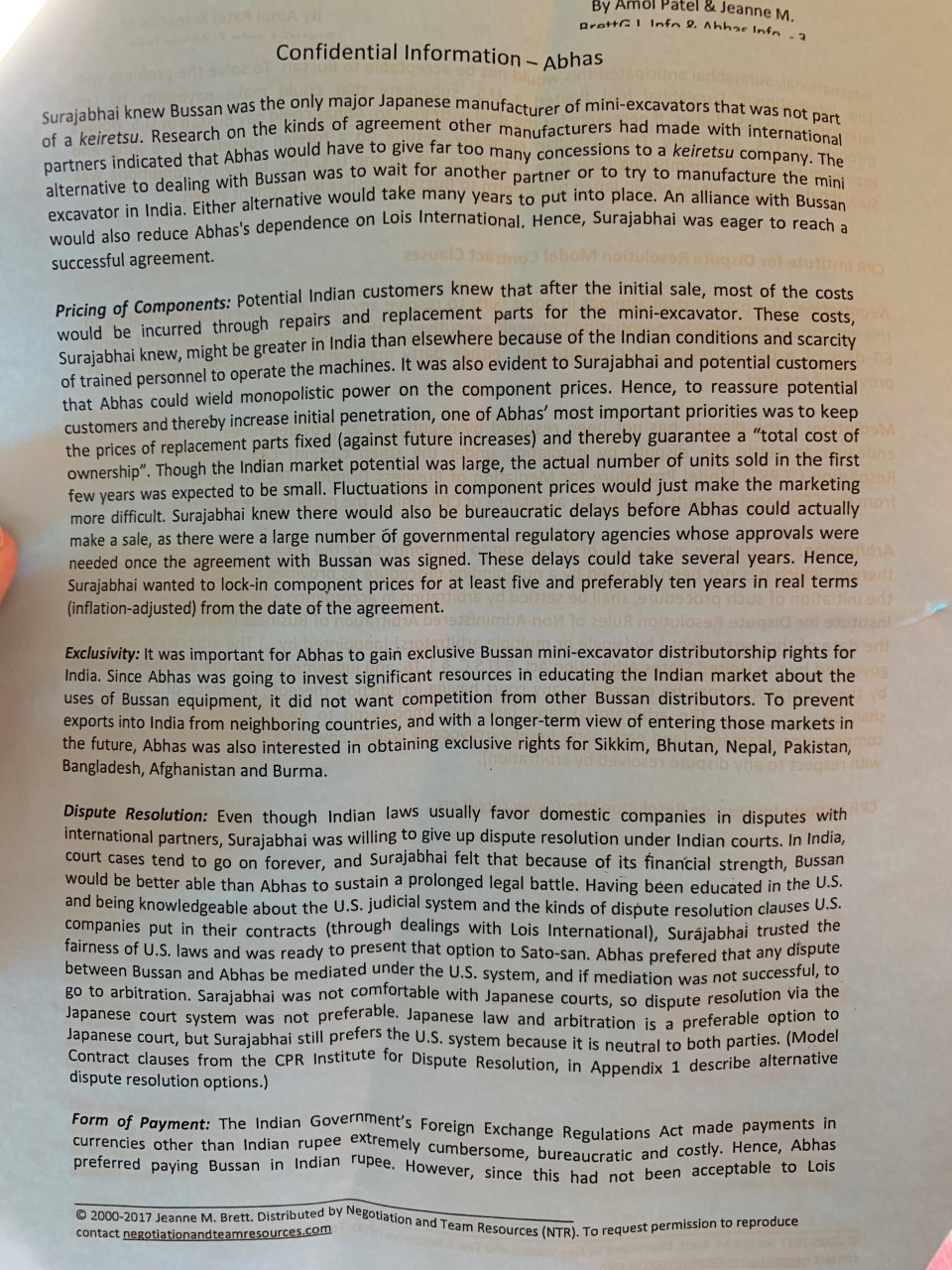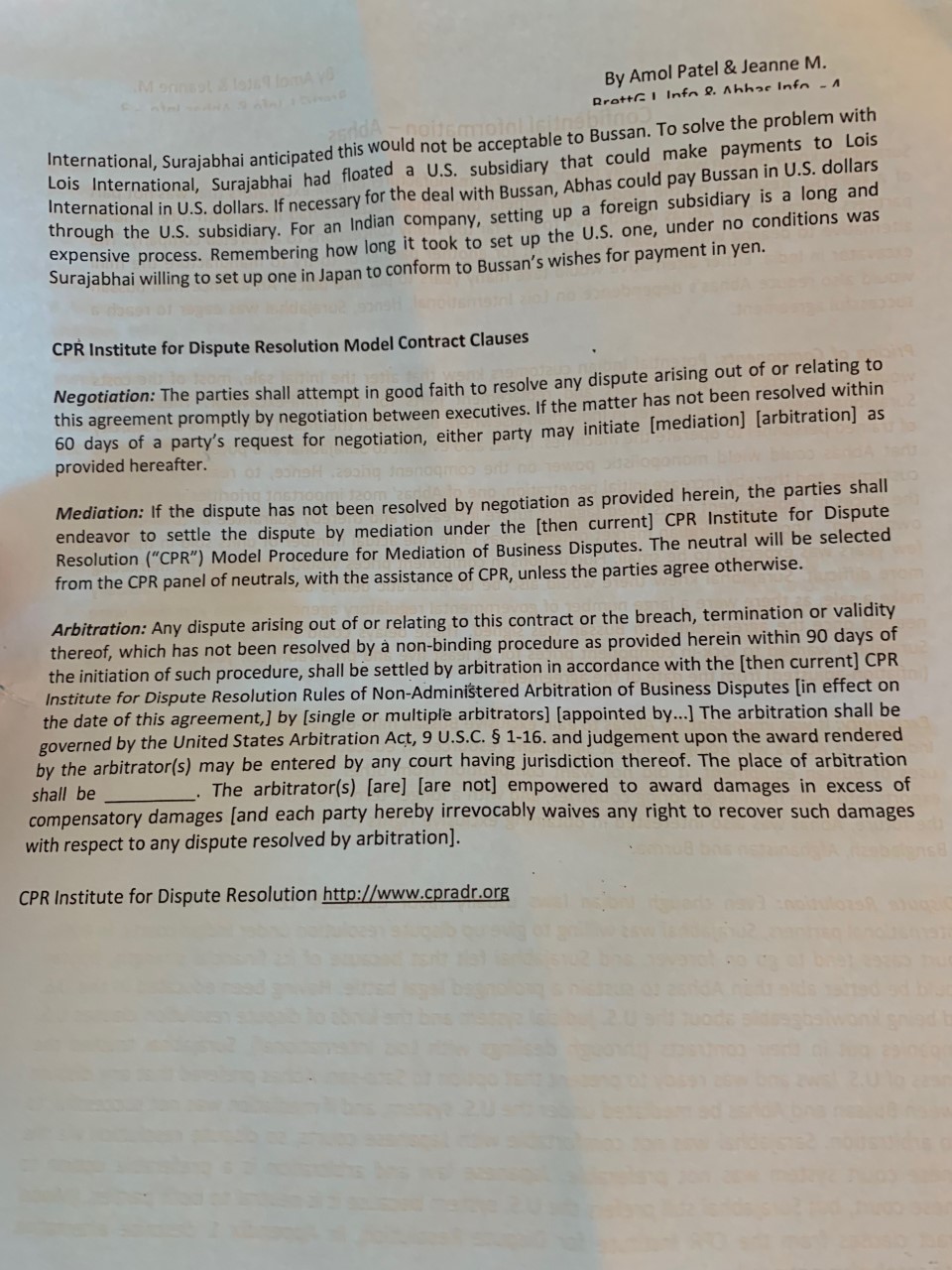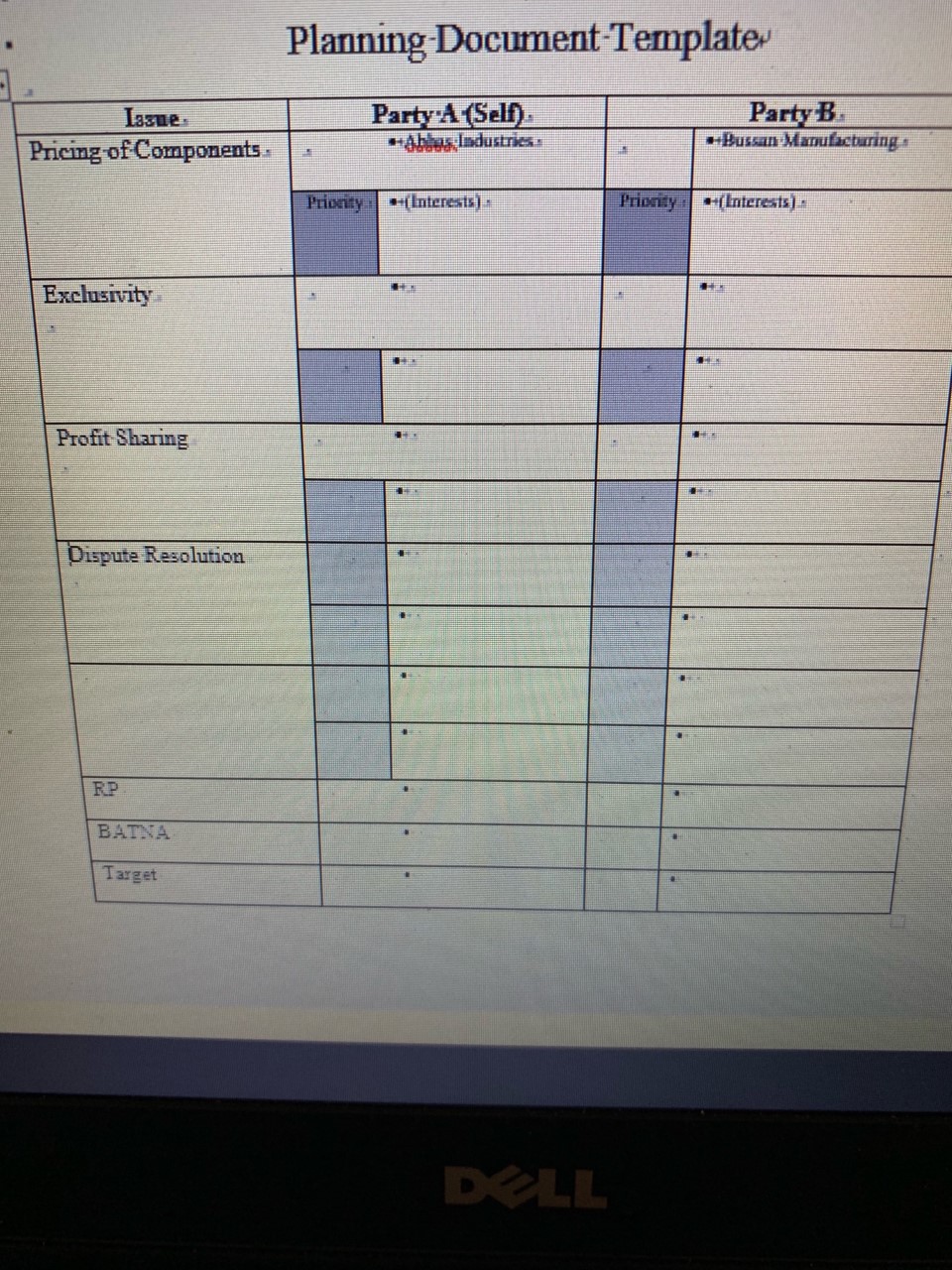what is the "price" and "exclusive" profit sharing "issues interests and priority
NIR By Amol Patel & Jeanne M. Brett Simonous Issufilog Ina sibal wine of acoins at noctua Abhas-Bussan Exercise abam gnhosniang to . General Information and Role of Abhas anhsentigns nishgo bazogotq VISV. 26W n5 of salv yismimilung demiol c Abhas Industries Private Limitedsom 101 2sabi bnis ughalways coinsay riautorit IesdidA dilw boradigm lizzoq 9rid 19biznon of grilliw zew nez case pileup Abhas Industries is a manufacturer/distributor of the American giant Lois International's line of skid- nu steer loaders (earth-moving machinery) for India. Abhas is the only Indian company to have an industrial x9 license from the Government of India to manufacture excavators (another kind of earth-moving 1269 machinery). The firm's annual sales revenue is $3 million. It is 100% family owned. Its biggest market oog presence is in India. You ant Negotiator: Surajabhai, Founder, President & CEO. Surajabhai is an entrepreneur who has thorough 9 knowledge of the Indian market. Born and raised in engineering, Surajabhai successfully established and grew India and educated in the U.S. at the graduate level 12 years before starting Abhas. In addition to good relations grew a U.S. multinational's presence in India for tions with U.S. companies, Surajabhai has cultivated good relations with a number of companies in the USSR while leading Indian trade delegations to that country. Being a non-aligned nati ed nation, India has special bilateral trade agreements with the USSR and many East-European nations, and therefore many contacts. Bussan Manufacturing Company Limited Bussan Manufacturing is one of Japan's largest manufacturers of mini-excavators, which are similar to excavators but have more niche applications. Bussan controls 25-30% of the worldwide share. Annual sales revenue is $500 million. Its biggest market presence is Japan and Western Europe. Negotiator: Akihiro Sato (Sato-san) - Founder, President. Sato-san is a scientist and widely respected for engineering genius. Known as the 'Inventor of Mini-Excavators', Sato-san has more than 45 years of engineering experience. Sato-San is proud of the fact that Bussan is still 100% family-owned, whereas competitors have periodically been acquired by Japanese conglomerates. Mini-excavators have become popular in Japan and Western Europe where working spaces are small and labor is expensive. Although these factors are not prevalent in India, Surajabhai has identified a unique opportunity for mini-excavators in steel foundries, and wants to be the first to capitalize on this newfound market niche in South Asia. However, Abhas has neither the technology nor the manufacturing infrastructure to make mini-excavators on its own, hence Bussan was approached. Abhas is looking to expand operations and diversity beyond the current line of Lois International products. Although Bussan (not part of any keiretsu) has been very successful in Japan and Western Europe, it has faced formidable opposition from keiretsu companies in entering markets in other parts of the world. The context of these negotiations is an era prior to India's famous economic liberalization program of 1991; the political climate is unreceptive to foreign investment. The Indian market is extremely difficult to enter due to the Government of India's post-independence protectionist, inward-looking and socialist policies controlling foreign direct investments in India. Japan, on the other hand, is very actively entering 2000-2017 Jeanne M. Brett. Distributed by rotation and Team Resources (NTR). To request permission to reproduce contact negotiationandteamresources.comBy Amol Patel & Jeanne M. 1918 .M enneal 8 19189 lomA va Brotte= 1 Info ?. Ahhas Info - ? global markets for heavy manufacturing equipment. Bussan is anxious to enter India, lured by its huge potential, but does not have access to appropriate distribution channels. Therefore, it has been searching for an Indian partner who understands the segment and the prevalent political, economic, cultural and legal conditions. After an initial exchange of correspondence, Surajabhai and Abhas's vice-president of engineering made a formal, preliminary visit to Bussan. At that visit, the Abhas team proposed certain engineering changes, which, in their opinion, might improve the efficiency of the mini-excavator. Sato-san was very impressed with Abhas' thorough technical knowledge and ideas for modifications that would better dA meet Indian conditions. A stickler for high quality, Sato-san was willing to consider the possibility of transferring technology to Abhas for purposes of manufacturing certain Bussan components. The dA excellent personal relationship that had been cultivated between the two presidents, a deep respect for each other's technical knowledge and sound business acumen motivated both presidents to search for a good agreement. d all .banwe vlimet decor i suneven 29162 Isun The key issues to be negotiated are: Pricing of Components; Exclusivity; Dispute Resolution; and Form of Payment. 3 2sd ord 1subsng off 36 .2.U brit-ni betsbubs/bris sibel ni (6102 totoional ibal ni sonessig allenoilsnuflum .2.( 6 weig ons barialldsize vilulazgoaug faridsisiue .shesigns n arts to sabelword 102 (esinsgmos .2.U fiw enolisles boog of nohibbs nl .earldA gninisie stoled assy SE anibal swirlw 8220 aris ni esinagmoo to edmun s ifiw eroitslen boog baysvulvo osu Isisslid (sipage and sion! nolan benalle-non signed .yunion feds of and ingslab alosinos yosm s1019195 bris enolisn nEsgow3-1253 yrsm bas 9220 ard div borimil yougmod gohubsslungMinszedd bhow art to beGE-as alouines ns2eud enolissilags sral 9go13 n19129W bris nsql al son929iq isthem lesgeld 231 .noillim 0028 al gunavan as162 lomasy 20 nardi som 26 062-0162 , 21016vsox3-iniM to joineval' ed) 26 pwon) auingg enheaniana acciaiw , benwo-ylimel d00 (life ei nseeud Jarl jost grif to buonq al ns2-of62 .sanshsoxs gonssniping .asfarsmolgnos seensgel yd beniupas need ylisalbahog svs 21ofingmon Isma sis 2506ge gnithow 918w sqois metzsW bnis nags mislugog.amongd svard 21018V63X9-ni s beflitnabi earl landsjsu2 , sibal ni islavanq son 916 anojp) gegrit riquoiNA savianogus et nods! b art no exilstigso of Jand art ed of alnew bnis , 2sibnuol lesta ni molevsoxs-inim to1 Winunoqgo upin mention 25 26ddA 19vowoH sizA rituof ni spain istham bouolwe 18 sangri nwo all no 21015Voxminimalism of butsuvicini enjoys fun bringye of priNoo all alol to sil ing dsbimsoloBy Amol Patel & Jeanne M. Brotte: | Info ?. Ahhar Info - 2 Confidential Information - Abhas Surajabhai knew Bussan was the only major Japanese manufacturer of mini-excavators that was not part of a keiretsu. Research on the kinds of agreement other manufacturers had made with international partners indicated that Abhas would have to give far to far too many concessions to a keiretsu company. The alternative to dealing with Bussan was to wait for another partner or to try to manufacture the mini excavator in India. Either alternative would take many years to put into place. An alliance with Bussan would also reduce Abhas's dependence on Lois International. Hence, Surajabhai was eager to reach a successful agreement. 292usID Jonno? IsboM noilulozoff aluqaid no) ofulitznj 943 Pricing of Components: Potential Indian customers knew that after the initial sale, most of the costs would be incurred through repairs and replacement parts for the mini-excavator. These costs, Surajabhai knew, might be greater in India than elsewhere because of the Indian conditions and scarcity of trained personnel to operate the machines. It was also evident to Surajabhai and potential customers that Abhas could wield monopolistic power on the component prices. Hence, to reassure potential customers and thereby increase initial penetration, one of Abhas' most important priorities was to keep the prices of replacement parts fixed (against future increases) and thereby guarantee a "total cost of ownership". Though the Indian market potential was large, the actual number of units sold in the first few years was expected to be small. Fluctuations in component prices would just make the marketing more difficult. Surajabhai knew there would also be bureaucratic delays before Abhas could actually make a sale, as there were a large number of governmental regulatory agencies whose approvals were needed once the agreement with Bussan was signed. These delays could take several years. Hence, Surajabhai wanted to lock-in component prices for at least five and preferably ten years in real terms (inflation-adjusted) from the date of the agreement. 19JelnimbA-noll to zeluf noitulozan Exclusivity: It was important for Abhas to gain exclusive Bussan mini-excavator distributorship rights for India. Since Abhas was going to invest significant resources in educating the Indian market about the uses of Bussan equipment, it did not want competition from other Bussan distributors. To prevent exports into India from neighboring countries, and with a longer-term view of entering those markets in the future, Abhas was also interested in obtaining exclusive rights for Sikkim, Bhutan, Nepal, Pakistan, Bangladesh, Afghanistan and Burma. Dispute Resolution: Even though Indian laws usually favor domestic companies in disputes with 490 international partners, Surajabhai was willing to give up dispute resolution under Indian courts. In India, court cases tend to go on forever, and Surajabhai felt that because of its financial strength, Bussan would be better able than Abhas to sustain a prolong olonged legal battle. Having been educated in the U.S. and being knowledgeable about the U.S. judicial system and the kinds of dispute resolution clauses U.S. companies put in their contracts (through dealings with Lois International), Surajabhai trusted the fairness of U.S. laws and was ready to present that option to Sato-san. Abhas prefered that any dispute between Bussan and Abhas be mediated under the U.S. system, and if mediation was not successful, to go to arbitration. Sarajabhai was not comfortable with Japanese courts, so dispute resolution via the Japanese court system was not preferable. Japanese law and arbitration is a preferable option to Japanese court, but Surajabhai still prefers the U.S. system because it is neutral to both parties. (Model Contract clauses from the CPR Institute for Dispute Resolution, in Appendix 1 describe alternative dispute resolution options.) Form of Payment: The Indian Government's Foreign Exchange Regulations Act made payments in currencies other than Indian rupee moremely cumbersome, bureaucratic and costly. Hence, Abhas preferred paying Bussan in Indian rupee. However, since this had not been acceptable to Lois @ 2000-2017 Jeanne M. Brett. Distributeisolation and Team Resources (NTR), To request permission to reproduce contact negotiationandteamresources.comM oninset & leigh lomA Yo By Amol Patel & Jeanne M. Brotte= 1 Info 8. Ahhar Info - 1 International, Surajabhai anticipated this would not be acceptable to Bussan. To solve the problem with Lois International, Surajabhai had floated a U.S. subsidiary that could make payments to Lois International in U.S. dollars. If necessary for the deal with Bussan, Abhas could pay Bussan in U.S. dollars through the U.S. subsidiary. For an Indian company, setting up a foreign subsidiary is a long and expensive process. Remembering how long it took to set up the U.S. one, under no conditions was Surajabhai willing to set up one in Japan to conform to Bussan's wishes for payment in yen. CPR Institute for Dispute Resolution Model Contract Clauses Negotiation: The parties shall attempt in good faith to resolve any dispute arising out of or relating to this agreement promptly by negotiation between executives. If the matter has not been resolved within provided hereafter. 60 days of a party's request for negotiation, either party may initiate [mediation] [arbitration] as Mediation: If the dispute has not been resolved by negotiation as provided herein, the parties shall endeavor to settle the dispute by mediation under the [then current] CPR Institute for Dispute Resolution ("CPR") Model Procedure for Mediation of Business Disputes. The neutral will be selected from the CPR panel of neutrals, with the assistance of CPR, unless the parties agree otherwise. Arbitration: Any dispute arising out of or relating to this contract or the breach, termination or validity thereof, which has not been resolved by a non-binding procedure as provided herein within 90 days of the initiation of such procedure, shall be settled by arbitration in accordance with the [then current] CPR Institute for Dispute Resolution Rules of Non-Administered Arbitration of Business Disputes [in effect on the date of this agreement,] by [single or multiple arbitrators] [appointed by...] The arbitration shall be governed by the United States Arbitration Act, 9 U.S.C. $ 1-16. and judgement upon the award rendered shall be by the arbitrator(s) may be entered by any court having jurisdiction thereof. The place of arbitration _. The arbitrator(s) [are] [are not] empowered to award damages in excess of compensatory damages [and each party hereby irrevocably waives any right to recover such damages with respect to any dispute resolved by arbitration]. CPR Institute for Dispute Resolution http://www.cpradr.orgPlanning Document Template Issue. Party.A (Self) Party B. Pricing of Components .Abbas Industries. -+Bussan Manufacturing . Priority .+( Interests) Priority (Interests) . Exclusivity Profit Sharing Dispute Resolution RP BATNA Target DELL
